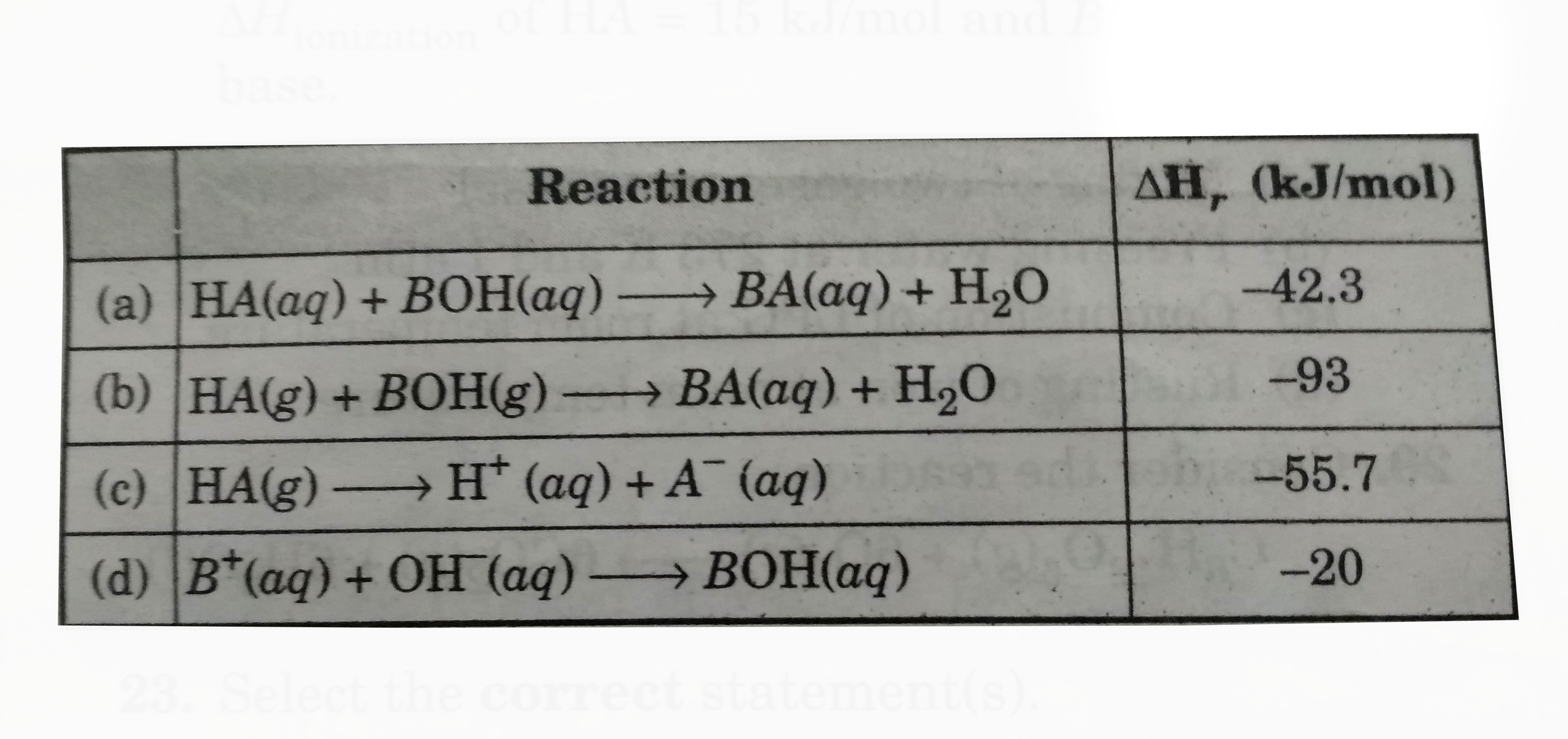Calculate the resonance energy of gaseous benzene from the given data
ΔHC−H=416,ΔHC−C=331,ΔHC=C=591,ΔHsub(C,graphite)=718
ΔHdiss(H2,g)=436 and ΔHf(benzene,g)=83 (all unit in kJmole−1)
354
271
437
83
The correct Answer is:B
To calculate the resonance energy of gaseous benzene, we will follow these steps:
Step 1: Write the formation reaction of benzene
The formation of gaseous benzene from graphite and hydrogen can be represented as:
6C (graphite)+3H2(g)→C6H6(g)
Step 2: Calculate the enthalpy change for the formation reaction (ΔH1)
Using the bond enthalpies provided:
- Each benzene molecule has 6 C-H bonds and 3 C-C bonds (considering resonance structures).
- The bond enthalpy for C-H is 416 kJ/mol, C-C is 331 kJ/mol, and C=C is 591 kJ/mol.
The enthalpy change for breaking the bonds in benzene can be calculated as:
ΔH1=−(6×ΔHC−H+3×ΔHC−C)
Substituting the values:
ΔH1=−(6×416+3×331)
ΔH1=−(2496+993)=−3489 kJ/mol
Step 3: Calculate the enthalpy change for sublimation of graphite (ΔH2)
The sublimation of graphite to gaseous carbon can be represented as:
6C (graphite)→6C (g)
The enthalpy change for this reaction is:
ΔH2=6×ΔHsub(C,graphite)=6×718=4308 kJ/mol
Step 4: Calculate the enthalpy change for dissociation of hydrogen (ΔH3)
The dissociation of hydrogen gas to form atomic hydrogen can be represented as:
3H2(g)→6H (g)
The enthalpy change for this reaction is:
ΔH3=3×ΔHdiss(H2)=3×436=1308 kJ/mol
Step 5: Combine the enthalpy changes to find the overall reaction enthalpy
Now, we can combine the enthalpy changes:
ΔHformation=ΔH1+ΔH2+ΔH3
Substituting the values:
ΔHformation=−3489+4308+1308=1127 kJ/mol
Step 6: Calculate the resonance energy
The resonance energy can be calculated using the formula:
Resonance Energy=ΔHcalculatedf−ΔHtheoreticalf
Where:
- ΔHcalculatedf=1127 kJ/mol
- ΔHtheoreticalf=83 kJ/mol
Substituting the values:
Resonance Energy=1127−83=1044 kJ/mol
Final Answer
The resonance energy of gaseous benzene is 1044 kJ/mol.
The formation of gaseous benzene from graphite and hydrogen can be represented as:
6C (graphite)+3H2(g)→C6H6(g)
Using the bond enthalpies provided:
- Each benzene molecule has 6 C-H bonds and 3 C-C bonds (considering resonance structures).
- The bond enthalpy for C-H is 416 kJ/mol, C-C is 331 kJ/mol, and C=C is 591 kJ/mol.
ΔH1=−(6×ΔHC−H+3×ΔHC−C)
Substituting the values:
ΔH1=−(6×416+3×331)
ΔH1=−(2496+993)=−3489 kJ/mol
The sublimation of graphite to gaseous carbon can be represented as:
6C (graphite)→6C (g)
The enthalpy change for this reaction is:
ΔH2=6×ΔHsub(C,graphite)=6×718=4308 kJ/mol
The dissociation of hydrogen gas to form atomic hydrogen can be represented as:
3H2(g)→6H (g)
The enthalpy change for this reaction is:
ΔH3=3×ΔHdiss(H2)=3×436=1308 kJ/mol
Now, we can combine the enthalpy changes:
ΔHformation=ΔH1+ΔH2+ΔH3
Substituting the values:
ΔHformation=−3489+4308+1308=1127 kJ/mol
The resonance energy can be calculated using the formula:
Resonance Energy=ΔHcalculatedf−ΔHtheoreticalf
Where:
- ΔHcalculatedf=1127 kJ/mol
- ΔHtheoreticalf=83 kJ/mol
Resonance Energy=1127−83=1044 kJ/mol
The resonance energy of gaseous benzene is 1044 kJ/mol.
Topper's Solved these Questions
- THERMODYNAMICSBOOK - RESONANCE ENGLISHCHAPTER - THERMODYNAMICSEXERCISE - Exercise -2 Part-I: Only one option correct type
23 Videos
- THERMODYNAMICSBOOK - RESONANCE ENGLISHCHAPTER - THERMODYNAMICSEXERCISE - Exercise-2 II: Single and double value integer type
16 Videos
- THERMODYNAMICSBOOK - RESONANCE ENGLISHCHAPTER - THERMODYNAMICSEXERCISE - H-1
1 Videos
- TEST SERIESBOOK - RESONANCE ENGLISHCHAPTER - TEST SERIESEXERCISE - CHEMISTRY
50 Videos
Similar Questions
Calculate the resonance energy of toluene (use Kekule structure from the following data
C7H8(l)+9O2(g)→7CO2(g)+4H2O(l)+ΔH,ΔHΘ=−3910kJmol−1
C7H8(l)→C7H8(g),ΔHΘ=38.1kJmol−1
ΔfHΘ(water)=−285.8kJmol−1
ΔfHΘ[CO2(g)]=−393.5kJmol−1
Heat of atomisation of H2(g)=436.0kJmol−1
Heat of sublimation of C(g)=715.0kJmol−1
Bond energies of C−H,C−C, and C=C are 413.0,345.6, and 610.0kJmol−1.
View SolutionCalculate the C—C bond energy from the following data:
2C(graphite)+3H2(g)→C2H6(g),ΔH=−84.67kJ
C(graphite),→C(g)ΔH=716.7kJ
H2(9g),→2H(g)Δ=435.9kJ
Assume 416 as the C - H bond energy.
View SolutionCalculate the standard enthalpy of solution of AgCl(s) in water ΔH0f(AgCl,s)=−127.07kJmol−1,ΔH0f(Ag+,aq)=105.58kJmol−1,ΔH0f(Cl−,aq)=−167.35kJmol−1
View SolutionCalculate the standard enthalpy of solution of AgCl(s) in water ΔH0f(AgCl,s)=−127.07kJmol−1,ΔH0f(Ag+,aq)=105.58kJmol−1,ΔH0f(Cl−,aq)=−167.35kJmol−1
View SolutionEnthalpic of hydrogenation of ethene (C2H4) and benzene (C6H6) are -136.68 and 205.65kJmo1−1 respectively
Calculate the resonance energy of benzene
(a) C2H4(g)+H2(g)→C2H6,ΔH1=−136.68kJ mo1−1
(b) C6H6(1)+3H2(g)→C6H12,ΔH2=−205.65kJ mo1−1 .
View SolutionFrom the following date , mark the opation(s) where ΔH is correctly written for the given reaction .
Given: H+(aq)+OH−(aq)→H2O(l),
ΔH=−57.3kJ
ΔHsolutionHA(g)=−70.7kJmole
ΔHsolutionBOH(g)=−20kJmole
ΔHionzatoin of HA=15kJ/mole and BOH is a strong base.

View SolutionCalculate ΔU reaction for the hydrogenation of acetalence at constant volume and at 77∘C.
Given that −ΔHf(H2O)=−678 kcal mole , ΔHcomb(C2H2)=−310.1kcal/ms2
View SolutionCalculate the heat of combustion of benzene form the following data:
a. 6C(s)+3H2(g)→C6H6(l),ΔH=49.0kJ
b. H2(g)+1/2O2(g)→H2O(l),ΔH=−285.8kJ
c. C(s)+O2(g)→CO2(g),ΔH=−389.3kJ
View SolutionFind bond enthalpy of S-S bond from the following data:
C2H5−S−C2H5, ΔH∘f=−147.2kJ mol−1
C2H5−S−S−C2H5, ΔH∘f=−201.9kJ mol−1
S(g), ΔH∘f=222.8kJ mol−1
View SolutionC(s)→C(g),ΔH=716.7kJ
ΔH is the heat of …………… of graphite.
View Solution
